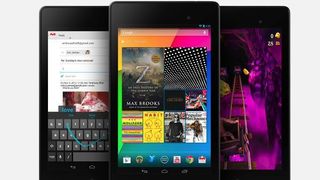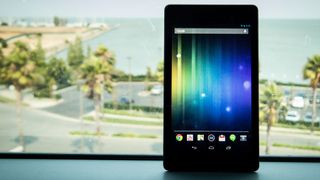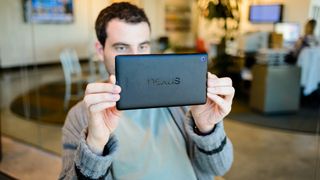TechRadar Verdict
If you're looking for a 7-inch tablet, we'll put it like this: there is no better alternative on the market. It's not quite as good as the new iPad mini, but if you don't fancy iOS this is the tablet you want.
Pros
- +
Great screen
- +
Affordable
- +
Strong battery life
Cons
- -
A lot of storage already occupied
- -
Colors are slightly inaccurate
- -
No 64GB option
Why you can trust TechRadar
The original Nexus 7 enchanted and enthralled - and did so despite some slight compromises. The fact that it was so cheap (£159 for a 16GB version) meant it remained outstanding value for a long time. Problem is, a year is a long time in the tablet world, and competition is fierce, so the new Nexus 7 is just what the doctor ordered.
And then in late July 2013, came the announcement. A new Nexus 7 - so good, they named it twice. (Some have differentiated it by adding the year to the name. For clarity, I'll refer to the old one as "the original Nexus 7-inch from now on.)
Of course, Nexus devices are synonymous with pure Google experiences. This is the chance for Mountain View to show off Android in its purest form, away from the meddling fingers of Samsung or HTC who just love to Sensify and TouchWiz up their devices.
The Nexus 7 launched with Android 4.3 Jelly Bean, which was a minor update from 4.2. It has since been updated to Android 4.4 KitKat, which adds a few bits and pieces to the bag of tricks, but I'll get into that later. I expect it will also be one of the first devices to get the next version update, whatever it may be….lemon meringue pie perhaps?
The Nexus 7 is still aiming for that sweet spot. The price has been bumped up - it's now £199 for the 16GB model that would have cost £159 before - but the specs are much better, so it's still very reasonably priced.

And it looks a lot better too. Whereas the original Nexus 7 looked like a medium level device, the new Nexus 7 now looks like a premium slab. I'll go into more detail in the next section, but suffice to say, it's pretty damn gorgeous.
It's only available in 16GB or 32GB versions - the latter will cost you a penny short of £240. And they are strictly Wi-Fi only. As with the previous incarnation, there's also a cellular version, and the difference this time is that the Nexus 7 is 4G LTE (vs HDSPA) compatible
If ever there was a tablet that you could just pick up and carry around with you, chuck easily in a bag and know it's there when you need it, then the Nexus 7 is the one.
Obviously, you'll need a case or some kind of protection as it'd be nothing short of criminal to scratch that beautiful glass screen, but I assume that most people will be practicing Safe Nexus 7 from the get-go.

It would be foolish to just go into the specs without comparing the Nexus 7 to its predecessor - that's what most people will be expecting. Suffice to say, this is one beautiful piece of equipment. The front is one sheet of high gloss Gorilla glass, interrupted only by the minute presence of a front-facing camera for selfies and Skypes.
It's thinner and lighter than before (200 x 114 x 8.7mm and 290g, compared to 198.5 x 120 x 10.5mm and 340g). Eagle-eyed mathematicians will notice there is a slight height increase, but it's negligible in practice. The LTE version adds another 9g.

Whereas before there was a plastic trim around the bezel, painted to look like metal, here it's gone. This is an all-black device. The screen just blends into the sides, which curve round to create an uninterrupted back panel. And if I had to find fault, it would be with this bit.
Firstly, the bezels have been shrunk right down to make the screen almost extend to the edges. But it makes it difficult to hold the Nexus 7, because the natural act of curling your hand around the tablet and resting your thumb on the bezel is now impossible without touching the screen and causing all kinds of annoyances. Instead, you have to rethink how you hold the tablet.
True, it can be held fully within the palm, but that's quite tiring after a while and not particularly comfortable. Others have taken to holding the Nexus 7 like a giant phone, resting the pinky at the bottom and the thumb at the side.

Yet while this is possible, it's again not the most comfortable experience. The power/sync port at the bottom ends up digging into the skin and the angular left hand corner digs into the palm.
Added to that, the back is no longer textured but a matte plastic, and therefore grip is reduced. It's not going to cause you sleepless nights, but it is going to bug some people (like me) at first. Thankfully, most people will keep their Nexus 7 in a case of some, and that makes this much less of an issue.
Another thing to mention is fingerprints. You have never seen a fingerprint magnet like this. Prepare for lots of rubbing the Nexus 7 against legs (preferably your own) to combat smudges.

Aside from that Micro USB port at the bottom, there is little to remark on. Asus and Google have deliberately gone for minimalism here.
Look hard on the front and you may see a notification light beneath the screen - but that only appears when your attention is needed. There's a power/sleep button on the right-hand side, accompanied by volume rocker.
On the back has an etched Nexus logo, along with another addition: the rear camera, which was one thing many original Nexus 7 owners craved. It's fine for showing someone something on Skype - but if you have intentions of using your tablet as a camera, as some antisocial types do, then frankly you need taking outside and giving a firm telling off to.

One thing you will notice is two lots of speakers - stereo, if you will. All mod cons here, it appears. They're on the top and bottom at the rear but the idea is that when you watch stuff in landscape, they'll be at the sides.
Oddly, they're at the back, facing away from you, which seems silly when you consider that HTC has moved the bar with the HTC One. But we'll find out how they fare a little later.
Altogether, this is a solid device. Where the original Nexus sometimes felt like a compromise due to the price (issues of light bleed and creakiness on the left hand side were common complaints), this feels like a premium, well-put-together piece of kit that should command more than the measly amount Google is asking.

This is definitely most apparent when you see the screen. The only word that fits here is "wow." The PPI of the original Nexus 7 represented one of its missed opportunities: at 216 (800 x 1280) it was by no means bad, but it always felt like it could have been just that little bit better.
And now it is. Google and Asus have pushed the density on the Nexus 7 up to the competition's level and beyond. It's now a staggering 323ppi (1200 x 1920). Consider the iPad's Retina display is 264ppi and you can imagine just how razor sharp this is. Text pops out and images look almost inexpressibly crisp.
Add to that the fact that there is virtually no gap between glass and screen, and this is a display to die for. Viewing angles could not be better - which is great, because tablets are more likely to be shared around than phones - and crispness is unmatched.
Naturally, the glass makes it less than ideal for outdoor use, but if you set brightness to maximum it should be able to cope.

Yes, it's a game of one upmanship to a certain degree. In all likelihood, you don't need a display that sharp. But by God, do I want it. And I love it. Sure, the Retina iPad Mini gives the Nexus 7 a run for its money, but you can't do much better on a tablet in terms of display.
Colour reproduction is also far better. A common complaint with the original Nexus 7 was that images tended to look faded and washed out. Again, I couldn't grumble too much because of the price, but it was one of those things that we geeks tended to notice and grind our teeth at. Thankfully, everything now just appears much warmer on the Nexus 7 than before.
It's still a world away from the brightness and vividity of Samsung's displays employed on the likes of the Note 8 or the Galaxy S4, but they are loved and loathed in equal measure. Some think they look great, while for others the effect is unnatural.
Either way, the fact is, unless you're odd, you won't pick up a Nexus 7, look at the display and feel disappointed in the slightest.

What you might feel disappointed with, however, is the storage issue. You won't find a Nexus 7 with anything more than 32GB of space - and remember, Google doesn't do external memory these days. In its efforts to push us all onto the cloud, you're stuck with what Google deems to be adequate.
And as we've become used to, that 32GB on the box doesn't mean you get 32GB to play with, as the OS takes up a huge chunk. You're left with just 26GB. With the size of some HD games, plus a couple of movies, you'll eat that up fairly easily. Obviously, the 16GB is even more dire in this regard.
There are two things Google could have done here: either given the option of a larger device (64GB or 128GB), or relented and left an SD slot for those who want to expand. Samsung still does that with the Note 8.0, as does Sony with the Xperia Tablet Z, and neither experience too many problems.
But larger memories would mean higher prices and that ruins the Nexus 7's USP. Increasing storage would mean Google losing face. It's a vicious circle, and it's the punters who lose out. If you are a media fiend, the paltry allowance might mean the Nexus 7 isn't the tablet for you, despite how great your content would look on that screen.

As with most modern devices, you'll find a sensor which adjusts the display to make sure you are getting optimum backlighting for battery power conservation. I found it to be pretty unremarkable - it just does what it should do.
However, if you decide to turn it off and put the display onto full manual brightness, make sure you've some sunglasses handy. This is one bright son of a gun, and you will be dazzled.
The battery has taken a hit, at least on paper. It's no longer 4325mAh and now reports for duty at 3950mAh. But Google appears to have some method in this madness. Aside from the fact that it makes the Nexus 7 lighter than the original, it doesn't seem to have much of an impact.
In fact, I'd say that the battery here is better than the original Nexus 7. Android 4.4 is great at battery management. When this unit goes to sleep, it goes to sleep. Not a slumber, not a doze, but a complete conk-out. And yet, it'll stand to attention at a second's notice when you need it again.

